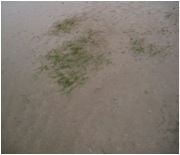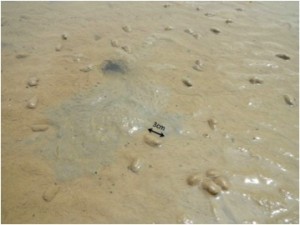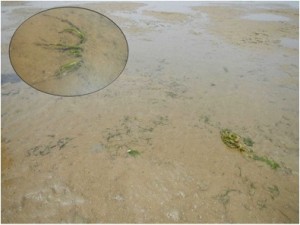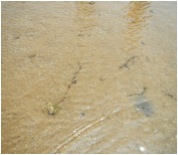Every so often (but only as often as we receive contributions) we feature a seagrass meadow from around the world. This week, Laura Soissons shares her observations of her field site in the Yellow River Delta in China. Laura is a PhD student with the Royal Netherlands Institute for Sea Research (NIOZ-Yerseke) studying human impacts on seagrass.
———————————————————
Photos & text by Laura Soissons
“Where are the seagrasses?” This is the main question my colleagues and I had in mind last summer when we were visiting our field site in the Yellow River Delta area in China. Sadly enough, we haven’t seen them make a comeback.
Seagrasses in the Yellow River Delta are the main topic of a collaborative project between the Royal Netherlands Institute for Sea Research (NIOZ-Yerseke) and the Yantai Institute for Coastal Zone Research (YIC-CAS) in China founded by the NSFC-NWO. As part of this project, my PhD research is, in a broad perspective, looking at the impact of human activities on seagrasses and how these activities can affect their resilience to environmental stresses. Our first and main focus is to understand the recent seagrass decline in the Yellow River Delta area.
And this is where the story starts…
When we first visited the area in 2011, we found a small and declining seagrass meadow southward of the Yellow river mouth, surrounded by dikes, oil platforms and salt industries. We called it: YR5.
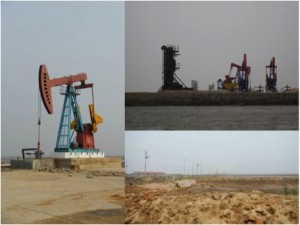
Pumpjacks, oil platforms and salt evaporation ponds on the coastline surrounding the seagrass meadow
The meadow was composed of a single seagrass species: Zostera japonica and showed a sparse and poor distribution over the tidal flat.
We progressively learnt about the recent dike construction around the area that cut kilometres of the tidal flat, and thus changed the whole shape of the area. We also discovered some interesting and dominant species like the snail Bullacta exarata, which is invading the entire area and used for aquaculture. Further research on this snail showed us that it originates from Korea and arrived in the area in 2008 after being placed and cultured there by humans for food. It mainly feeds on diatoms and organic matter at the sediment surface but not on seagrasses. Nevertheless, this species is now colonizing the entire tidal flat and remains one of the last living species there (together with crabs and a few bivalves).
Back to the YR5 field site at the end of May 2012, we had hard times finding the seagrasses. After hours of searching we finally found some even scarcer shoots in an area surrounded by the saltmarsh plant Spartina anglica in tussocks (invasive plant in that area). Local temperatures were already high enough to think that the seagrasses were late for the growing season… And when we looked at the shoots in more details, we saw how unhealthy they were: holes in the leaves, black leaves and very weak tissues.
Two weeks after this discovery, we came back to the exact same place. We found only dead rhizomes, and just a couple of shoots left with more black leaves than before. We even felt very guilty for having been sampling a few shoots two weeks before (samples for tissue analysis, trace elements and pollutants content).
We observed a highly dynamic system over the summer with strong winds and waves at high tide. Sediment was getting coarser and accreting, sometimes burying the seagrass shoots. For our final visit at the end of July, no seagrasses were left. The dead rhizomes were washed away or already degraded and the hours we spent looking for seagrasses remained unsuccessful.
There are many reasons that could explain the sudden collapse of this Zostera japonica meadow at YR5. It could be the anthropogenic influence but also a combination of changing environmental variables and pollution from the Yellow River and surroundings. So far, we found no historical data reporting the existence of this meadow or anything related to the status of this particular tidal flat before the dike construction in 2009 (from what we know). Observing the seagrass meadow decline over its ‘growing season’ showed us one more time how crucial it is to take into account our long-term influence on a meadow. Stakeholders in that area will not give up on expanding their activities but also want to consider their impact and the need to preserve their environment. Within our project we want to emphasize this seagrass loss by understanding more about the reasons of their decline and how we made it happen.
